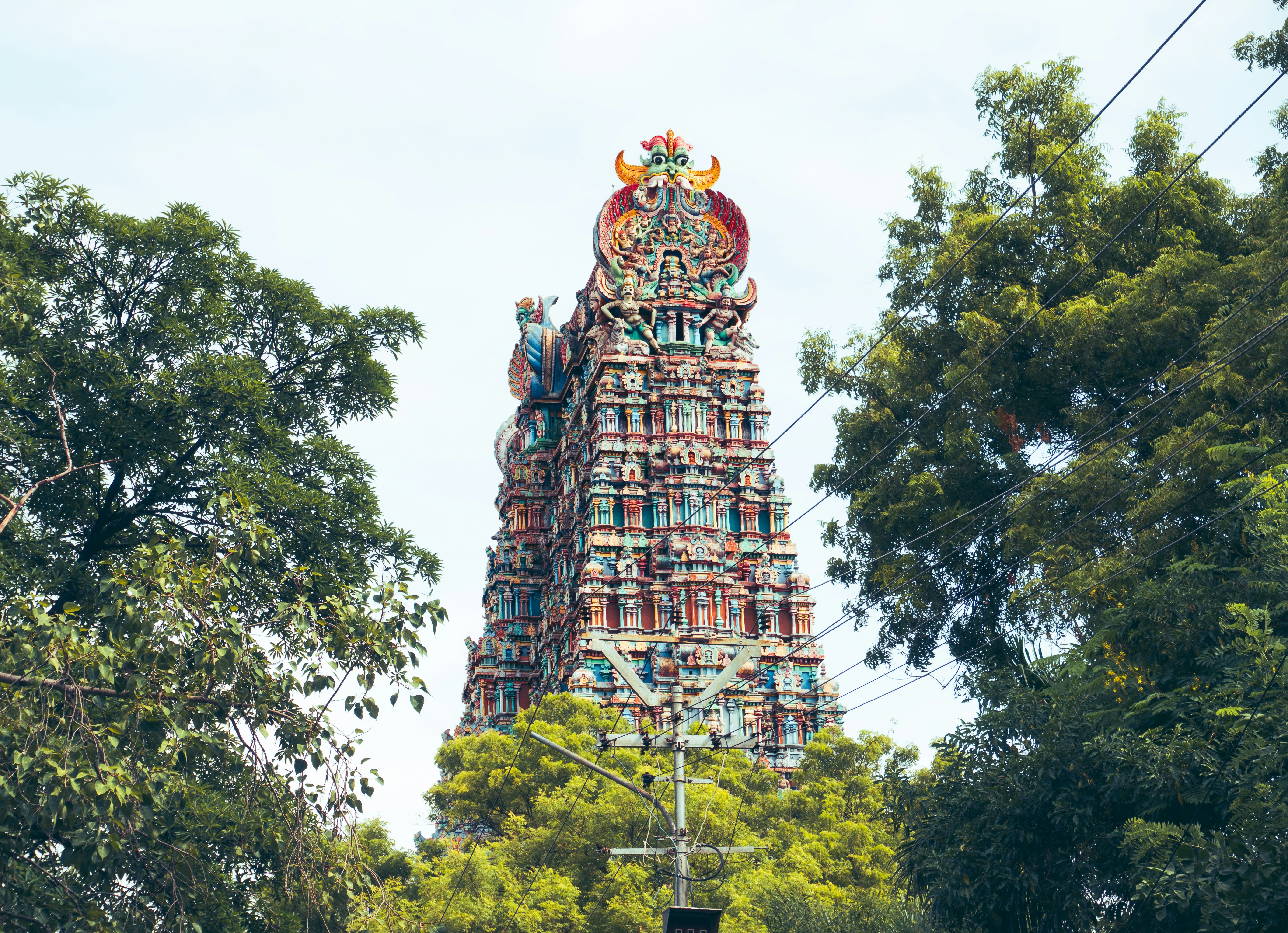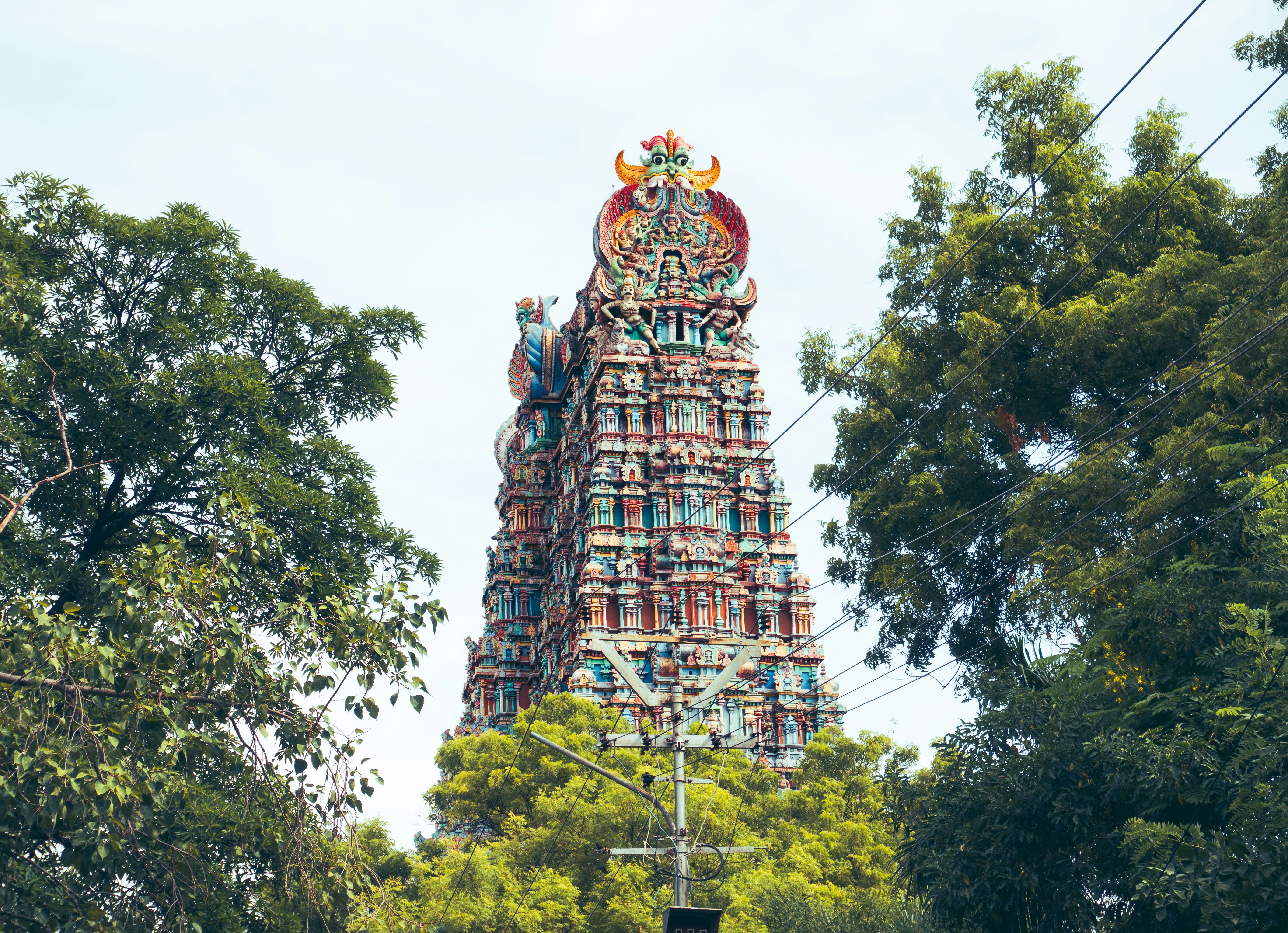History of the Meenakshi Temple
The history of the Meenakshi Temple dates back to the 6th century when it was initially built by the Pandyan dynasty. However, the temple, as we see it today, is the result of several renovations and expansions carried out by different rulers over the centuries. It was during the reign of the Nayak dynasty in the 16th century that the temple underwent significant transformations and reached its present grandeur. Legend has it that the temple was named after the goddess Meenakshi, an incarnation of the Hindu goddess Parvati. According to the mythology, Meenakshi was born with three breasts, and it was prophesied that she would marry Lord Shiva. The third breast disappeared when she met Lord Shiva, and they got married in a grand ceremony. This mythical story is depicted in various sculptures and paintings within the temple complex.
Architectural Brilliance
The Meenakshi Temple is a remarkable example of Dravidian architecture, a style prevalent in South India. The temple complex spans over 45 acres and is adorned with intricately carved sculptures, towering gopurams (gateway towers), and majestic halls. The main shrine of the temple is dedicated to Goddess Meenakshi, while the secondary shrine is dedicated to Lord Shiva, her consort. One of the most striking features of the temple is its gopurams, which are elaborately decorated with sculptures depicting various gods, goddesses, and mythological scenes. The tallest gopuram, known as the Rajagopuram, stands at an impressive height of 170 feet and is adorned with over 1500 sculptures. These sculptures narrate stories from Hindu mythology and showcase the exquisite craftsmanship of the artisans of that era. The temple also houses several mandapams (halls) that serve as gathering spaces for devotees and tourists. The Thousand Pillar Hall is a notable attraction, known for its intricately carved pillars and exquisite sculptures. Each pillar in this hall is unique and showcases the mastery of the sculptors who worked on them.
Significance of the Meenakshi Temple
The Meenakshi Temple holds immense religious and cultural significance for the people of Madurai and Tamil Nadu as a whole. It is not only a place of worship but also a center for art, music, and dance. The temple hosts several festivals throughout the year, the most famous being the Meenakshi Tirukalyanam, a grand celebration of the divine wedding of Goddess Meenakshi and Lord Shiva. Apart from its religious importance, the Meenakshi Temple is also a major tourist attraction and a UNESCO World Heritage Site. Its architectural splendor and historical significance draw visitors from all over the world, who come to witness the grandeur of this ancient temple. In conclusion, the Meenakshi Temple in Madurai is a testament to the rich cultural heritage and architectural brilliance of ancient India. Its history, architectural features, and religious significance make it a must-visit destination for anyone interested in exploring the glorious past of this region. The Meenakshi Temple is not only a place of worship but also a testament to the rich cultural heritage of the region. Its architectural grandeur and intricate carvings are a sight to behold. The temple complex covers an area of about 45 acres and is a city within itself. It is divided into several concentric quadrangular enclosures, each with its own gateways, towers, and halls. The main entrance of the temple is through the East Gopuram, which is adorned with colorful sculptures depicting various mythological stories. As one enters the temple, they are greeted by the awe-inspiring Thousand Pillar Hall, which is a masterpiece of Dravidian architecture. The hall is adorned with intricately carved pillars, each unique in its design. It is said that no two pillars in the hall are alike. Walking further into the temple complex, one comes across the Golden Lotus Tank, an ancient water tank that is believed to have healing properties. Devotees often take a dip in the tank before entering the main sanctum. The main sanctum, or the Garbhagriha, is a place of divine energy and devotion. It is here that devotees offer their prayers and seek blessings from the deities. The temple is not only a religious center but also a hub of cultural activities. Festivals like Meenakshi Thirukalyanam, the celestial wedding of Goddess Meenakshi and Lord Sundareswarar, attract thousands of devotees from far and wide. The temple also hosts music and dance performances, showcasing the rich cultural heritage of the region. Over the centuries, the Meenakshi Temple has undergone several renovations and additions. The rulers and patrons of the temple have left their mark by adding new structures and embellishments. The temple’s towers, or gopurams, are a prominent feature and are adorned with intricate sculptures and carvings. Each gopuram tells a story, depicting scenes from Hindu mythology. The Meenakshi Temple is not just a place of worship but a living symbol of the history and culture of Madurai. It stands as a testament to the architectural brilliance and artistic prowess of the people who built it. Visiting the temple is not just a religious experience but a journey through time, immersing oneself in the grandeur of the past and the devotion of the present. The Thousand Pillar Hall is not only a visual marvel but also a testament to the advanced engineering techniques employed during its construction. The pillars are made of granite and have been meticulously carved to perfection. Each pillar is adorned with intricate motifs, including floral patterns, mythical creatures, and scenes from Hindu mythology. The craftsmanship and attention to detail in these pillars are truly awe-inspiring. Walking through the Thousand Pillar Hall, visitors are transported to a different era, where art and architecture were revered and celebrated. The hall exudes a sense of grandeur and spirituality, making it a popular spot for meditation and contemplation. The acoustics of the hall are also remarkable, with even the slightest whisper echoing throughout the space. Beyond the Thousand Pillar Hall lies the sanctum sanctorum, where the main deities, Goddess Meenakshi and Lord Sundareswarar, are enshrined. The sanctum is adorned with gold and precious stones, creating a divine aura that is palpable to all who enter. Devotees flock to the temple from all corners of the world to seek the blessings of the divine couple and to experience the spiritual energy that permeates the sacred space. Apart from its architectural beauty, the Meenakshi Temple is also a center for cultural and religious activities. Festivals like Meenakshi Thirukalyanam, the celestial wedding of Goddess Meenakshi and Lord Sundareswarar, attract thousands of devotees and tourists alike. The temple complex also houses various smaller shrines dedicated to different gods and goddesses, providing a comprehensive spiritual experience for visitors. In conclusion, the Meenakshi Temple is not just a place of worship but also a testament to the rich cultural heritage of India. Its architectural splendor, intricate carvings, and spiritual ambience make it a must-visit destination for anyone interested in art, history, and spirituality. Whether you are a devotee seeking divine blessings or a traveler in search of beauty and tranquility, the Meenakshi Temple offers an experience that is truly unparalleled. The Meenakshi Temple is not only a religious site but also a hub of cultural activities. It serves as a platform for artists to showcase their talents in various forms. The temple hosts regular music and dance performances, attracting artists and art enthusiasts from all over the world. These performances not only entertain the visitors but also help in preserving and promoting the traditional art forms of the region. One of the most significant festivals celebrated at the Meenakshi Temple is the Meenakshi Thirukalyanam, which is a grand event that attracts thousands of devotees. This festival marks the divine wedding of Goddess Meenakshi and Lord Sundareswarar. The temple premises are beautifully decorated, and the whole atmosphere is filled with joy and devotion during this time. Devotees come from far and wide to witness this auspicious occasion and seek the blessings of the divine couple. Apart from the religious and cultural significance, the Meenakshi Temple is also an architectural marvel. The temple’s construction dates back to the 16th century when it was rebuilt by the Nayak rulers. The intricate carvings on the temple walls and pillars are a testament to the skill and craftsmanship of the artisans of that time. Each carving tells a story from Hindu mythology, making the temple not just a place of worship but also a visual representation of the rich cultural heritage of the region. As you enter the temple complex, you are greeted by the towering gopurams (entrance towers) that are adorned with vibrant sculptures and paintings. These gopurams not only serve as gateways to the temple but also act as a symbol of the grandeur and magnificence of the Meenakshi Temple. The main shrine of the temple is dedicated to Goddess Meenakshi, who is believed to be an incarnation of the Hindu goddess Parvati. The sanctum sanctorum of the temple houses the idol of the goddess, which is beautifully decorated with jewels and flowers. Walking through the corridors of the temple, you will come across various smaller shrines dedicated to different deities. Each shrine has its own unique architecture and design, adding to the overall charm of the temple complex. The temple also has a sacred tank called the Porthamarai Kulam, which is believed to possess healing properties. Devotees take a dip in this holy tank before entering the main shrine, as it is believed to cleanse the body and soul. Visiting the Meenakshi Temple is not just a religious experience but also a cultural and spiritual journey. The temple’s serene atmosphere and the scent of incense create a tranquil environment where one can introspect and connect with their inner self. The rhythmic chants and devotional songs that fill the air add to the spiritual ambiance of the temple, creating a sense of peace and harmony. In conclusion, the Meenakshi Temple in Madurai is not just a place of worship but also a center for art, culture, and spirituality. Its significance goes beyond religious boundaries and attracts people from all walks of life. Whether you are a devout believer, an art enthusiast, or simply someone seeking solace, a visit to the Meenakshi Temple is an experience that will leave a lasting impression.
Enter your email to get the Latest Updated Exploring News and Topics
Discover more from atozexplore.com
Subscribe to get the latest posts sent to your email.







